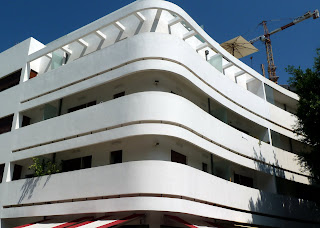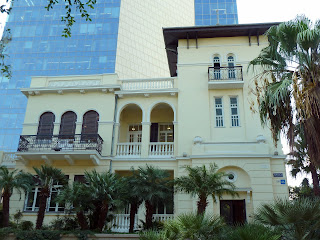Some months ago, as we were in the process of planning our journey and deciding where to live for our five-month stay in Israel, we ran into two of our Israeli friends who live in the Bay Area. We asked one of them where we should live and he responded: "Whatever you do, don't live in Tel Aviv. It's not the 'real' Israel. It's just a big city like everywhere else, and if you live there, you won't get the sense that you've lived anywhere different." We then asked our other friend the same question. Unaware of the first response, she said: "You shouldn't live anywhere but Tel Aviv. It's the only place in Israel where you can really have fun - the beaches, bars, restaurants, cafes, the shopping - nothing's going on anywhere else." Naturally, we were confused, but as another Israeli friend told us: "Ask one million Israelis for advice, and you'll get one million different opinions."
 |
| One of Tel Aviv's ubiquitous fruit stands |
Love it or hate it, Tel Aviv is more than just a posh party beach town (although it certainly is that!). True, the city's nicknames include "the City that never sleeps," "the Miami of the Middle East," and "the Mediterranean capital of cool." And for most of the long history of neighboring Jaffa, Tel Aviv was nothing more than an empty landscape of sand dunes, having celebrated its centennial only last year. (Click
here for our updated and expanded blog post about the ancient port of Jaffa, which some claim is more than 4,000 years old.)
But Tel Aviv has packed a lot into its short history. It's a thriving economic hub, a hot destination for chefs and foodies, and a living museum of modern architecture.
 |
| Our friend Yossie enjoys a lemonade at HaCarmel Market |
In the early 1880s, Yemeni Jews began leaving neighboring Jaffa to build homes in what is today the Kerem Hateimanim neighborhood in southern Tel Aviv. Also in the 1880s, Ashkenazi Jews left Europe to settle in Israel, some choosing to develop the empty sands north of Jaffa in what is today the Neve Tzedek neighborhood in southern Tel Aviv. Until recently, Neve Tzedek was quiet and run-down, but gentrification is now proceeding apace - and is pushing up prices, attracting upscale businesses (think wine bars, French restaurants, and gelato), and radically changing the demographics of the area. We found these two early neighborhoods to be the most interesting in the city, with their smaller scale and neighborhood feel contrasting sharply with the densely urbanized city center to the north.
 |
| Spices at HaCarmel |
The official beginning of Tel Aviv was marked in 1909 by a gathering of about 60 families on a desolate sand dune on what is now the fashionable, tree-lined Rothschild Avenue. They divvied up lots by lottery, using seashells. You certainly couldn't get any land today in the city using seashells - Tel Aviv is one of the 20 most expensive cities in the world for real estate, comparable to London and Rome.
The city has grown steadily since its founding 101 years ago, most dramatically in the 1930s, when Jews fleeing Europe tripled the city's population, which reached 160,000 in 1939. Today, the population is around 400,000, but it feels like a much larger city due to the 24-hour-a-day hustle and bustle and the immense amount of commerce.
 |
| Hassan Bek Mosque, near the seafront |
With two small children in tow, we haven't really experienced Tel Aviv's famous nightlife or trendy restaurants, but during our daytime wanderings we have marveled at the striking array of 20th century building styles that the city streets have to offer. Tel Aviv has been called the "White City," as it contains the world's largest concentration of white Bauhaus buildings and for this reason was designated in 2003 as a UNESCO World Heritage Site. Many of the Jewish architects who trained at the Bauhaus, a Modernist school of architecture in Germany that the Nazis shut down in 1933, fled to Israel and left their mark on Tel Aviv. But the architects of Tel Aviv also used other architectural styles, including Art Deco, classical revival, and an eclectic Orientalist style that combined European designs with Middle Eastern elements such as arches, domes and other ornamental features.
 |
| Even the statues in Tel Aviv drink coffee! |
After years of neglect, there's been a flurry of renovation in recent times. The result is a unique and fascinating blend of dilapidated relics that look like they're on the verge of collapse, next to beautifully restored buildings that recall the styles of the 1920s and 1930s, next to buildings that combine designs across different generations, next to purely contemporary buildings, next to classic urban skyscrapers (and, like most modern cities, Tel Aviv does have its share of nondescript buildings). One author has called Tel Aviv's architectural mix a "curious, often unsightly mishmash" and a "visual cacophony," but it really is a pleasure to stroll from neighborhood to neighborhood, admire the contrasting architectural styles, and observe the latest renovation projects. And, of course, take a lot of pictures...
Here are some examples of the "White City" Bauhaus style (though the last building hasn't seen a true shade of white in some time):
But it's not just about Bauhaus. Here are some other pictures that attempt to capture what we liked about the different architectural styles in Tel Aviv.
So, come to Tel Aviv - to swim, to eat, to play, to drink coffee, to drink arak (tastes and acts like ouzo), to stay out real, real late (unless you have young children), and to gaze at all the buildings...








































Wow! I really need a Tel Aviv tourist to roam around with. I'd say I haven't seen most of those buildings!
ReplyDelete